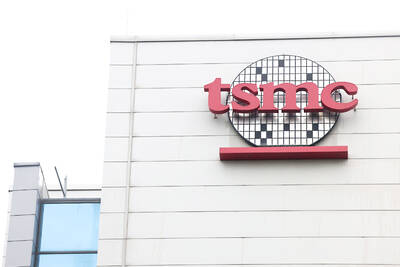Exports last month grew a tepid 4.3 percent year-on-year to US$37.48 billion, as shipments linked to artificial intelligence (AI) remained the lone bright spot, while all other product categories weakened amid a slow season, the Ministry of Finance said yesterday.
The figure suggested an uneven recovery and was disappointing compared with the ministry’s forecast of an increase of 8 to 11 percent, Department of Statistics Director-General Beatrice Tsai (蔡美娜) said.
“It is hard to capture the world’s business pulse as uncertainties linked to inflation, monetary policies and geopolitical tensions escalate,” Tsai said.

Photo: CNA
It is safe to say that the previous impressive rebounds were technical in nature and mainly due to lower comparison bases last year, she said.
Tsai said that shipments this month might expand 7 to 10 percent.
Exports to the US last month surged 81.6 percent to a historic high of US$10.16 billion, whereas exports to China decreased 11.3 percent to US$11.3 billion, the ministry’s report showed.
Tsai attributed it to US technology giants aggressively building up AI infrastructure and capacities, while Chinese firms increasingly depend on domestic suppliers amid the technology rivalry with the US.
Exports to Japan tumbled by a record 39.6 percent to US$1.93 billion, Tsai said.
Shipments to Europe slid 6.5 percent and a mild 2.8 percent to ASEAN markets, the report showed.
“The global economic recovery looked uneven and bumpy,” Tsai said.
Exports of information and communication technology products spiked 114.6 percent to US$11.74 billion, single-handedly driving 31.3 percent of the total volume, Tsai said.
Shipments of electronic components fell 17.7 percent to US$12.95 billion, with semiconductors shrinking a faster 18.8 percent due to unfavorable seasonality for consumer electronic gadgets, she said.
Although AI demand remained robust, sales of smartphones and PCs were lukewarm, Tsai said.
Likewise, exports of optical devices plunged 33.5 percent, machinery equipment shed 13 percent and transportation tools weakened 20 percent, ministry data showed.
Shipments of plastic, chemical, base metal and mineral products were equally bleak, retreating by 3.2 percent to 27.9 percent, the data showed.
By contrast, imports last month expanded by a faster 6.6 percent to US$31.02 billion, as local firms bought more input materials for exports and capital equipment for capacity expansion, Tsai said.
In particular, imports of semiconductor equipment grew 17.9 percent to US$2.39 billion, she said.
Last month’s trade figures gave Taiwan a trade surplus of US$6.46 billion, down 5.4 percent from a year earlier, the report showed.
Exports in the first four months expanded 10.6 percent to US$147.81 billion, while imports edged up 3.8 percent to US$122.39 billion, it said.

When an apartment comes up for rent in Germany’s big cities, hundreds of prospective tenants often queue down the street to view it, but the acute shortage of affordable housing is getting scant attention ahead of today’s snap general election. “Housing is one of the main problems for people, but nobody talks about it, nobody takes it seriously,” said Andreas Ibel, president of Build Europe, an association representing housing developers. Migration and the sluggish economy top the list of voters’ concerns, but analysts say housing policy fails to break through as returns on investment take time to register, making the

EARLY TALKS: Measures under consideration include convincing allies to match US curbs, further restricting exports of AI chips or GPUs, and blocking Chinese investments US President Donald Trump’s administration is sketching out tougher versions of US semiconductor curbs and pressuring key allies to escalate their restrictions on China’s chip industry, an early indication the new US president plans to expand efforts that began under former US president Joe Biden to limit Beijing’s technological prowess. Trump officials recently met with their Japanese and Dutch counterparts about restricting Tokyo Electron Ltd and ASML Holding NV engineers from maintaining semiconductor gear in China, people familiar with the matter said. The aim, which was also a priority for Biden, is to see key allies match China curbs the US

The popular Taiwan Semiconductor Manufacturing Co (TSMC, 台積電) arbitrage trade might soon see a change in dynamics that could affect the trading of the US listing versus the local one. And for anyone who wants to monetize the elevated premium, Goldman Sachs Group Inc highlights potential trades. A note from the bank’s sales desk published on Friday said that demand for TSMC’s Taipei-traded stock could rise as Taiwan’s regulator is considering an amendment to local exchange-traded funds’ (ETFs) ownership. The changes, which could come in the first half of this year, could push up the current 30 percent single-stock weight limit

NOT TO WORRY: Some people are concerned funds might continue moving out of the country, but the central bank said financial account outflows are not unusual in Taiwan Taiwan’s outbound investments hit a new high last year due to investments made by contract chipmaker Taiwan Semiconductor Manufacturing Co (TSMC, 台積電) and other major manufacturers to boost global expansion, the central bank said on Thursday. The net increase in outbound investments last year reached a record US$21.05 billion, while the net increase in outbound investments by Taiwanese residents reached a record US$31.98 billion, central bank data showed. Chen Fei-wen (陳斐紋), deputy director of the central bank’s Department of Economic Research, said the increase was largely due to TSMC’s efforts to expand production in the US and Japan. Investments by Vanguard International